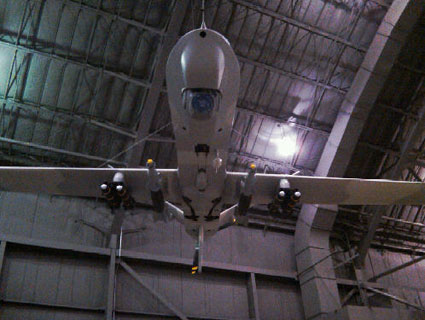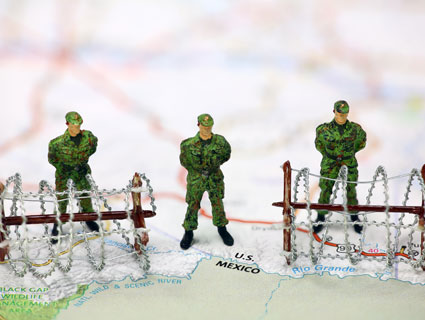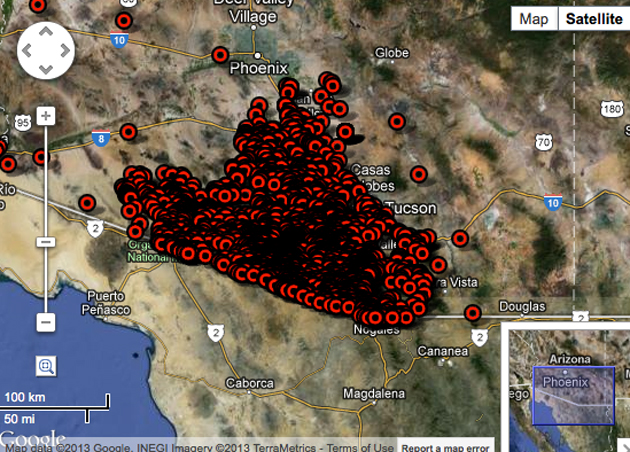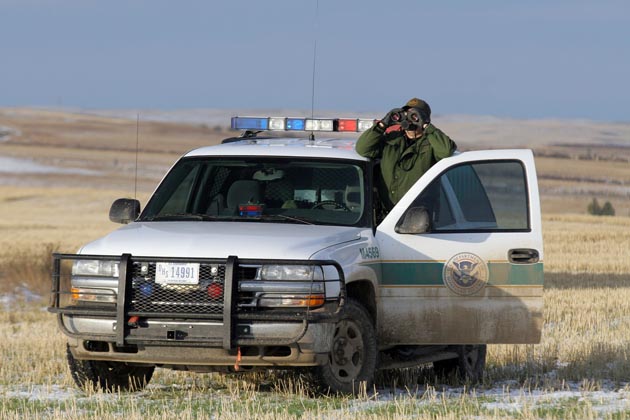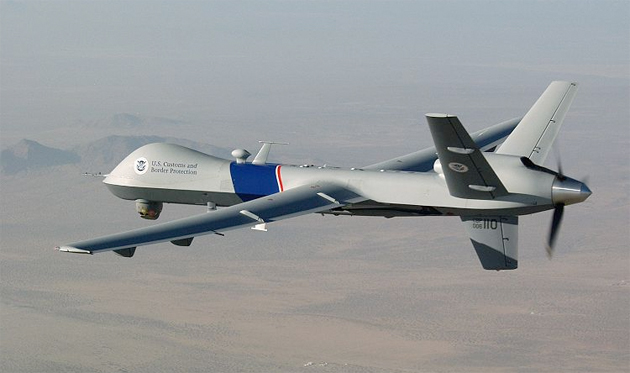
<a href="https://en.wikipedia.org/wiki/File:MQ-9_Reaper_CBP.jpg">Gerald L Nino</a>/Wikimedia Commons
This story first appeared on the TomDispatch website.
The first thing I did at the Border Security Expo in Phoenix this March was climb the brown “explosion-resistant” tower, 30 feet high and 10 feet wide, directly in the center of the spacious room that holds this annual trade show. From a platform where, assumedly, a border guard would stand, you could take in the constellation of small booths offering the surveillance industry’s finest products, including a staggering multitude of ways to monitor, chase, capture, or even kill people, thanks to modernistic arrays of cameras and sensors, up-armored jeeps, the latest in guns, and even surveillance balloons.
Although at the time, headlines in the Southwest emphasized potential cuts to future border-security budgets thanks to Congress’s “sequester,” the vast Phoenix Convention Center hall—where the defense and security industries strut their stuff for law enforcement and the Department of Homeland Security (DHS)—told quite a different story. Clearly, the expanding global industry of border security wasn’t about to go anywhere. It was as if the milling crowds of business people, government officials, and Border Patrol agents sensed that they were about to be truly in the money thanks to “immigration reform,” no matter what version of it did or didn’t pass Congress. And it looks like they were absolutely right.
All around me in that tower were poster-sized fiery photos demonstrating ways it could help thwart massive attacks and fireball-style explosions. A border like the one just over 100 miles away between the United States and Mexico, it seemed to say, was not so much a place that divided people in situations of unprecedented global inequality, but a site of constant war-like danger.
![]() Below me were booths as far as the eye could see surrounded by Disneyesque fake desert shrubbery, barbed wire, sand bags, and desert camouflage. Throw in the products on display and you could almost believe that you were wandering through a militarized border zone with a Hollywood flair.
Below me were booths as far as the eye could see surrounded by Disneyesque fake desert shrubbery, barbed wire, sand bags, and desert camouflage. Throw in the products on display and you could almost believe that you were wandering through a militarized border zone with a Hollywood flair.
To an awed potential customer, a salesman in a suit and tie demonstrated a mini-drone that fits in your hand like a Frisbee. It seemed to catch the technological fetishism that makes Expo the extravaganza it is. Later I asked him what such a drone would be used for. “To see what’s over the next hill,” he replied.
Until you visit the yearly Expo, it’s easy enough to forget that the US borderlands are today ground zero for the rise, growth, and spread of a domestic surveillance state. On June 27th, the Senate passed the Border Security, Economic Opportunity, and Immigration Modernization Act. Along with the claim that it offers a path to citizenship to millions of the undocumented living in the United States (with many stringent requirements), in its more than 1,000 pages it promises to build the largest border-policing and surveillance apparatus ever seen in the United States. The result, Senator John McCain proudly said, will be the “most militarized border since the fall of the Berlin Wall.”
This “border surge,” a phrase coined by Senator Chuck Schumer, is also a surveillance surge. The Senate bill provides for the hiring of almost 19,000 new Border Patrol agents, the building of 700 additional miles of walls, fences, and barriers, and an investment of billions of dollars in the latest surveillance technologies, including drones.
In this, the bill only continues in a post-9/11 tradition in which our southern divide has become an on-the-ground laboratory for the development of a surveillance state whose mission is already moving well beyond those borderlands. Calling this “immigration reform” is like calling the National Security Agency’s expanding global surveillance system a domestic telecommunications upgrade. It’s really all about the country that the United States is becoming—one of the police and the policed.
Low-Intensity War Zone
The $46 billion border security price tag in the immigration reform bill will simply expand on what has already been built. After all, $100 billion was spent on border “enforcement” in the first decade after 9/11. To that must be added the annual $18 billion budget for border and immigration enforcement, money that outpaces the combined budgets of all other federal law enforcement agencies. In fact, since Operation Blockade in the 1990s, the US-Mexico border has gone through so many surges that a time when simple chain link fences separated two friendly countries is now unimaginable.
To witness the widespread presence of Department of Homeland Security agents on the southern border, just visit that international boundary 100 miles south of Border Security Expo. Approximately 700 miles of walls, fences, and barriers already cut off the two countries at its major urban crossings and many rural ones as well. Emplaced everywhere are cameras that can follow you—or your body heat—day or night. Overhead, as in Afghanistan, a Predator B drone may hover. You can’t hear its incessant buzzing only because it flies so high, nor can you see the crew in charge of flying it and analyzing your movements from possibly hundreds of miles away.
As you walk, perhaps you step on implanted sensors, creating a beeping noise in some distant monitoring room. Meanwhile, green-striped Border Patrol vehicles rush by constantly. On the US-Mexican border, there are already more than 18,500 agents (and approximately 2,300 more on the Canadian border). In counterterrorism mode, they are paid to be suspicious of everything and everybody. Some Homeland Security vehicles sport trailers carrying All Terrain Vehicles. Some have mounted surveillance cameras, others cages to detain captured migrants. Some borderlanders like Mike Wilson of the Tucson-based Border Action Network, a member of the Tohono O’odham Nation (a Native American people and the original inhabitants of the Arizona borderlands), call the border security operatives an “occupying army.”
Checkpoints—normally located 20-50 miles from the international boundary—serve as a second layer of border enforcement. Stopped at one of them, you will be interrogated by armed agents in green, most likely with drug-sniffing dogs. If you are near the international divide, it’s hard to avoid such checkpoints where you will be asked about your citizenship—and much more if anything you say or do, or simply the way you look, raises suspicions. Even outside of the checkpoints, agents of the Department of Homeland Security can pull you over for any reason—without probable cause or a warrant—and do what is termed a “routine search.” As a US Border Patrol agent told journalist Margaret Regan, within a hundred miles of the international divide, “there’s an asterisk on the Constitution.”
 Off-road forward operating bases offer further evidence of the battlefield atmosphere being created near the border. Such outposts became commonplace during the US wars in Iraq and Afghanistan, where they were meant to house US soldiers deployed into remote areas. On the border, there are high-tech yet rudimentary camps that serve the same purpose. They also signal how agents of the Department of Homeland Security are “gaining, maintaining, and expanding” into rural areas traversed by migrants and used by smugglers, though to this point never crossed by a known international terrorist.
Off-road forward operating bases offer further evidence of the battlefield atmosphere being created near the border. Such outposts became commonplace during the US wars in Iraq and Afghanistan, where they were meant to house US soldiers deployed into remote areas. On the border, there are high-tech yet rudimentary camps that serve the same purpose. They also signal how agents of the Department of Homeland Security are “gaining, maintaining, and expanding” into rural areas traversed by migrants and used by smugglers, though to this point never crossed by a known international terrorist.
These rural areas, especially in Arizona, are riddled with migrant causalities. More than 6,000 “remains” have been recovered since the mid-1990s, deaths not for the most part from bullets but from exposure. The US borderlands, according to sociologist Timothy Dunn, started to become a militarized zone as early as the 1970s—in part, in response to the Pentagon’s low-intensity conflict doctrine. With Congressional immigration reform, if it passes the House of Representatives, it may very well become a full-fledged war zone.
Since the 1990s, the strategy of the Border Patrol has been termed “prevention by deterrence” and has been focused on concentrating agents and surveillance technologies in urban areas, once the traditional migrant routes. The idea was to funnel migrant flows into areas too dangerous and desolate to cross like the triple-degree-temperature desert in Arizona. Deadly yes; impossible to cross, no. Although unauthorized border-crossings have slowed down in recent years, tens of thousands continue to cross into the United States annually from Mexico and Central America, thanks in part to the continued havoc of the North American Free Trade Agreement, which left more two million Mexican farmers unemployed.
I met Adira, a 21-year-old from Oaxaca, Mexico, in early June. She told me a story all too common in Arizona. As she described her experience, I realized that I was talking to somebody who had probably died and been brought back to life. We were only a few blocks from the border. Homeland Security had formally deported her only days before. Still reliving the trauma of her experience, she stared down, her face colorless, as she talked.
I had heard the basics of her story so many times before: to avoid the militarized surveillance apparatus, she and her companions walked for at least five days through the southern Arizona desert with little—and then no—water or food. By the fourth day, the mountains began to talk to her, so she told me, and she suspected she was coming to the end of her young life. After she couldn’t walk any more, the guide dragged her, telling her constantly: “We just have to make it to the next point.”
When they reached a road on the American side of the border, she remembers convulsing four times (just as she remembers blood bursting spontaneously from the noses of her companions). And then she remembers no more. She woke up in a hospital. There were scars on her chest. Medics must have used a machine, she thought, to shock her back to life. She found out later that somebody had lit a fire to attract the Border Patrol. She’s lucky not to be among those remains regularly found out in that desert.
In other words, each further tightening of the border is a death sentence passed on yet more Latin Americans. According to a statement by a group of Tucson organizations, including No More Deaths and the Coalición de Derechos Humanos, the border build-up in the immigration reform bill promises more of the same: “Make no mistake: this bill will lead to more deaths on the border.”
The Laboratory
In early March, DRS Technologies set up its integrated fixed-tower technology at the University of Arizona’s (UA) Science and Technology Park, just south of Tucson, an hour from the border, and very close to where Adira almost lost her life. The company was eager to show off the long-range surveillance technology it had been developing for borders in places like Egypt and Jordan.
It set up a mock operational control room to do a dog-and-pony show for the local media. Four of its IT guys then focused their cameras on an elevated railroad spur more than four miles away in the middle of the desert where two men were approaching each other to consummate a fake drug deal. One handed the other a backpack. It was all vividly watchable on DRS’s video screens. Although the odds of such a scenario actually happening ranged from slim to none, the demonstration was a reminder of just how fertile the US-Mexico borderlands are for defense- and surveillance-related companies. It’s here that new generations of surveillance technology are regularly born and developed.
For almost a decade, the Department of Homeland Security has been attempting to build a “virtual wall” along the border—not a physical barrier but a high-tech surveillance masterpiece, a complex web of technology, radar, unattended ground sensors, and camera systems meant to detect anyone crossing the border anywhere. The last attempt to install such an experimental system along part of the border was in 2006. Then the Department of Homeland Security awarded Boeing Corporation a multi-billion-dollar contract to develop such a “wall,” known as SBInet. That contract was abruptly cancelled in 2011, after the costly and delayed program advertised as offering “unprecedented situational awareness” misfired regularly in the rugged terrain of the Arizona borderlands. Now, companies like DRS are standing in line for the next round of potentially lucrative contracts, as Homeland Security wants “to finish the job.”
The UA Tech Park is one place in the southern borderlands where surveillance technology can be developed, tested, evaluated, and demonstrated. It has 18,000 linear feet of fencing surrounding its “solar zone,” a solar-technology-centric research area ideal for testing sensor systems along a future border wall. On any of the roadways in its 1,345 acres, it can set up mock border-crossings or checkpoints to test new equipment and methods. It draws on faculty and graduate students from the college of engineering. In “rapid-response teams,” they offer third-party evaluations of border control technology. Some of this same technology is also being created on the UA campus, thanks in part to millions of dollars in DHS grants.
Here, too, as Tech Park CEO Bruce Wright tells me, they can test new technologies “right in the field”—that is, on the border, presumably on real people. One of the tech park’s goals, he says, is to develop the first border security industry cluster of its kind in the United States. In southern Arizona alone, they have already identified 57 companies, big and small, working on border policing technology.
The Tech Park’s director of community engagement Molly Gilbert says, “It’s really about development, and we want to create technology jobs in our border towns.” These are sweet words for the economically depressed communities of southern Arizona, their poverty rates usually hovering at around 20%. With projected global revenues of approximately $20 billion in 2013 and a 5% growth rate that has withstood a worldwide recession, the global border security industry was flourishing even before the latest immigration reform proposal. Now, it’s poised for a potential bonanza.
The key, as Wright stressed in a 2012 interview, is that the products developed for the US-Mexican borderlands be marketed in the future for the US-Canada border, where “defenses” are already being upgraded, for other international borders, but also for places that have little to do with borders. These might include the perimeters of utility companies and airports, or police forces with expanding national security and immigration enforcement missions.
“There’s a huge market for this technology worldwide,” Wright told me then, “because borders exist everywhere. There’s the Palestinian-Israeli border, there’s the Syrian-Israeli border, there’s the German-Polish border… Take it around the world and wherever you want to go there are borders, so the technology is very adaptable and has a market worldwide.”
The Surge
The word “surge,” last heard in relation to the US wars in Iraq and Afghanistan, actually fits the immigration reform bill perfectly. It’s almost as if a domestic war is about to be formally declared.
After all, the bill would come close to doubling the number of Border Patrol agents, bringing their ranks to 40,000—the size of a small army—stationed, according to Senator Lindsey Graham, every 1,000 feet along the nearly 2,000-mile border. To put that in perspective, the Border Patrol, created in 1924, took close to 70 years to reach 4,000 agents. In 2006, at 10,000 agents, it had its first major hiring surge, doubling its numbers. Many of the new agents were veterans from our wars in Iraq and Afghanistan. This new surge will mean collateral benefits for all sorts of businesses—more uniforms, more guns, more vehicles, more maintenance. And that’s just to scratch the surface of what’s likely to happen.
As Vermont Senator Patrick Leahy put it, this will be the “Christmas wish list for Halliburton,” and the border security industry, as at this year’s Border Security Expo, is visibly licking its chops. Senator Marco Rubio laid out the following list or, as the trade magazine Homeland Security Today called it, “treasure trove” of products that it expected to be ordered if the bill passed: 86 integrated fixed towers, 286 fixed camera systems, 232 mobile surveillance systems, 4,595 unattended ground sensors, 820 handheld equipment devices, 416 personal radiation detectors, 104 radiation isotope identification devices, 62 mobile automated targeting systems, 53 fiber-optic tank inspection scopes, 37 portable contraband detectors, 28 license plate readers, 26 mobile inspection scopes and sensors for checkpoints, nine land automated targeting systems, and eight non-intrusive inspection systems.
In addition, Rubio said, the immigration bill would include “four unmanned aircraft systems, six VADER radar systems, 17 UH-1N helicopters, eight C-206H aircraft upgrades, eight AS-350 light enforcement helicopters, 10 Blackhawk helicopter 10 A-L conversions, five new Blackhawk M Model, 30 marine vessels, 93 sensor repeaters, 90 communications repeaters, two card-reader systems, five camera refresh, three backscatters, one radiation portal monitor, one littoral detection, one real-time radioscopy, and improved surveillance capabilities for existing aerostat.”
The reform package calls for “persistent surveillance” and 24/7 drone flights, although the areas of these flights are not specified. Even before the Senate reform bill came into view, San Diego-based General Atomics was awarded a contract that would add 14 more drones to the current fleet of 10 used by Customs and Border Protection (CBP, the parent agency of the Border Patrol). CBP plans to have 18 drones in flight by 2016 and 24 in the years to follow patrolling US skies over cities such as San Diego, Tucson, and El Paso—not to speak, in the north, of Seattle, Detroit, and Buffalo.
Some of these drones will be equipped with the VADER “man-hunting” radar system, made by Northrup Grumman, used to detect roadside bombers in Afghanistan. Now, even more of this technology will be put to use in the borderlands, where, according to CBP, it is aready locating unauthorized border-crossers. Recently declassified documents also show that CBP has been considering upgrading its drones with “non-lethal” weapons to be able to take down “targets of interest.”
According to the New York Times, other military-industrial behemoths like Raytheon and Lockheed Martin are actively looking for “revenue flows” as “wars wind down.” Teams of lobbyists, including former New York Senator Alfonse D’Amato, have been pressing the Department of Homeland Security on behalf of their corporate clients. D’Amato lobbies for the United Technologies Corporation, which stands to make millions off an immigration bill that will okay the purchase of 15 of its Blackhawk helicopters. This is but one example of the increasingly powerful set of corporate interests eager to see immigration reform pass now in the House of Representatives. A vote could come as early as Labor Day.
But whatever happens, it’s time to stop thinking of all this as “immigration reform.” It represents what may be the most intense concentration of the surveillance state in a single location ever witnessed—a place where the Constitution has an asterisk, which means that anything goes and dystopian worlds of all sorts can be invented.
The Los Angeles Times has written that, if passed, the bill “would also be a boost to defense contractors and an economic stimulus for border communities, creating thousands of jobs that could raise home prices and spur consumer spending around border security stations.” It sounds like Keynesian economics, but of a whole different sort.
In a world where basic services are being cut, an emerging policing apparatus in the borderlands is flourishing. As Mattea Kramer and Chris Hellman reported at TomDispatch in February, since September 11, 2001, the United States has spent $791 billion on “homeland security” alone, an inflation-adjusted $300 billion more than the cost of the entire New Deal.
In those borderlands, we are seeing the birth of a military-industrial-immigration complex. It seems destined to shape our future.
Todd Miller has researched and written about US-Mexican border issues for more than 10 years. He has worked on both sides of the border for BorderLinks in Tucson, Arizona, and Witness for Peace in Oaxaca, Mexico. He now writes on border and immigration issues for NACLA Report on the Americas and its blog “Border Wars,” among other places. He is at work on his first book, Border Patrol Nation, for the Open Media Series of City Lights Books.
Follow TomDispatch on Twitter and join us on Facebook or Tumblr. Check out the newest Dispatch book, Nick Turse’s The Changing Face of Empire: Special Ops, Drones, Proxy Fighters, Secret Bases, and Cyberwarfare.To stay on top of important articles like these, sign up to receive the latest updates from TomDispatch.com here.
